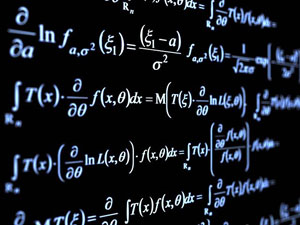- Theorem 6-1.
A necessary and sufficient condition for
to be independent of the path
joining any two given points in a region
is that in


where it is supposed that these partial derivatives are continuous in
.
The condition (23) is also the condition that
is an exact differential, i.e. that there exists a function
such that
. In such case if the end points of curve
are
and
, the value of the line integral is given by
![\displaystyle \int_{(x_1, y_1)}^{(x_2, y_2)}[Pdx + Qdy] = \int_{(x_1, y_1)}^{(x_2, y_2)} d\phi = \phi(x_2, y_2) - \phi(x_1, y_1) \cdots(24) \displaystyle \int_{(x_1, y_1)}^{(x_2, y_2)}[Pdx + Qdy] = \int_{(x_1, y_1)}^{(x_2, y_2)} d\phi = \phi(x_2, y_2) - \phi(x_1, y_1) \cdots(24)](https://s0.wp.com/latex.php?latex=%5Cdisplaystyle+%5Cint_%7B%28x_1%2C+y_1%29%7D%5E%7B%28x_2%2C+y_2%29%7D%5BPdx+%2B+Qdy%5D+%3D+%5Cint_%7B%28x_1%2C+y_1%29%7D%5E%7B%28x_2%2C+y_2%29%7D+d%5Cphi+%3D+%5Cphi%28x_2%2C+y_2%29+-+%5Cphi%28x_1%2C+y_1%29+%5Ccdots%2824%29&bg=T&fg=000000&s=0)
In particular if (23) holds and
is closed, we have
and
![\displaystyle \oint_C [Pdx + Qdy] = 0\cdots(25) \displaystyle \oint_C [Pdx + Qdy] = 0\cdots(25)](https://s0.wp.com/latex.php?latex=%5Cdisplaystyle+%5Coint_C+%5BPdx+%2B+Qdy%5D+%3D+0%5Ccdots%2825%29&bg=T&fg=000000&s=0)
The results in Theorem 6-1 can be extended to line integrals in space. Thus we have
- Theorem 6-2.
A necessary and sufficient condition for
to be independent of the path
joining any two given points in a region
is that in

where it is supposed that these partial derivatives are continuous in
.
The results can be expressed concisely in terms of vectors. If
, the line integral can be written
and condition (26) is equivalent to the condition
. If
represents a force field
which acts on an object, the result is equivalent to the statement that the work done in moving the object from one point to another is independent of the path joining the two points if and only if
. Such a force field is often called conservative.
The condition (26) [or the equivalent condition
] is also the condition that
[or
] is an exact differential, i.e. that there exists a function
such that
. In such case if the endpoints of curve
are
and
, the value of the line integral is given by

In particular if
is closed and
, we have
タグ: force field
VECTOR NOTATION FOR LINE INTEGRALS
It is often convenient to express a line integral in vector form as an aid in physical or geometric understanding as well as for brevity of notation. For example, we can express the line integral (15) in the form
![\displaystyle \int_{C}[A_1dx + A_2dy + A_3dz] \\ = \int_{C} (A_1\bold{i} + A_2\bold{j} + A_3\bold{k}) \cdot (dx\bold{i} + dy\bold{j} + dz\bold{k})\\ = \int_{C} \bold{A}\cdot d\bold{r} \cdots (17) \displaystyle \int_{C}[A_1dx + A_2dy + A_3dz] \\ = \int_{C} (A_1\bold{i} + A_2\bold{j} + A_3\bold{k}) \cdot (dx\bold{i} + dy\bold{j} + dz\bold{k})\\ = \int_{C} \bold{A}\cdot d\bold{r} \cdots (17)](https://s0.wp.com/latex.php?latex=%5Cdisplaystyle+%5Cint_%7BC%7D%5BA_1dx+%2B+A_2dy+%2B+A_3dz%5D+%5C%5C++%3D+%5Cint_%7BC%7D+%28A_1%5Cbold%7Bi%7D+%2B+A_2%5Cbold%7Bj%7D+%2B+A_3%5Cbold%7Bk%7D%29+%5Ccdot+%28dx%5Cbold%7Bi%7D+%2B+dy%5Cbold%7Bj%7D+%2B+dz%5Cbold%7Bk%7D%29%5C%5C++%3D+%5Cint_%7BC%7D+%5Cbold%7BA%7D%5Ccdot+d%5Cbold%7Br%7D+%5Ccdots+%2817%29+&bg=T&fg=000000&s=0)
where
and
. The line integral (14) is a special case of this with
.
If at each point (x, y, z) we associate a force F acting on an object (i.e. if a force field is defined), then

represents physically the total work done in moving the object along the curve C.

